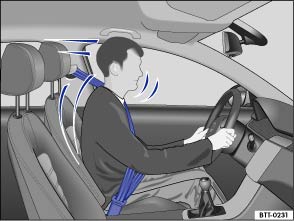Volkswagen Golf Owners Manual: Seat belt protection

Fig. 63 Driver restrained by a properly positioned seat belt during a sudden braking manoeuvre
 First read and observe the introductory information
and safety warnings
First read and observe the introductory information
and safety warnings Correctly fastened seat belts can make a major difference. When fastened properly, seat belts hold the vehicle occupants in the correct sitting positions and considerably reduce the kinetic energy in the event of an accident. Seat belts also help to prevent uncontrolled movements that could lead to severe injuries. In addition, wearing seat belts properly reduces the risk of being thrown from the vehicle .
Passengers wearing seat belts correctly benefit greatly from the ability of the belts to reduce the kinetic energy. The front crumple zones and other passive safety features (such as the airbag system) are also designed to reduce kinetic energy. The amount of energy generated will thus decrease, thereby reducing the risk of injury.
The examples describe frontal collisions. Of course, properly worn seat belts substantially reduce the risk of injury in all other types of accidents. This is why seat belts must be fastened before every trip – even if you are only planning to drive a very short distance. Ensure that all passengers also wear their seat belts properly.
Accident statistics have shown properly worn seat belts to be an effective means of substantially reducing the risk of injury and improving the chances of survival in a serious accident. Furthermore, properly worn seat belts improve the protection provided by airbags in the event of an accident. This is why wearing a seat belt is a legal requirement in most countries.
Although the vehicle is equipped with airbags, the seat belts must be fastened and worn. For example, the front airbags will only be triggered in certain types of frontal collision. The front airbags will not be triggered during minor frontal collisions, minor side collisions, rear collisions, rolls or accidents in which the airbag trigger threshold in the control unit is not exceeded.
Therefore, always wear your seat belt and ensure that your passengers have fastened their seat belts properly before you drive off.
 What happens to vehicle occupants who have not fastened their seat belts
What happens to vehicle occupants who have not fastened their seat belts
Fig. 61 An unbelted driver is thrown forwards
Fig. 62 The unbelted rear passenger is
thrown forwards, hitting the belted driver
First read and observe the introductory information
and safety ...
 Using seat belts
Using seat belts
First read and observe the introductory information
and safety warnings ...
Other materials:
Assist systems menu
First read and observe the introductory information
and safety warnings
Menu
Function
Lane Assist
Switches the lane departure warning system on and off
.
Front Assist
Switches the area monitoring system on or off .
...
Cleaning leatherette upholstery
First read and observe the introductory information
and safety warnings Please observe the following notes prior to cleaning
the leatherette upholstery .
Only use water and neutral detergents to clean the leatherette upholstery.
NOTICE
Do not use solvents, wax polish, shoe cream, spot ...
Checking holding pressure, engine code CWVA
Special tools and workshop equipment required
Removal wedge -3409-
Pressure tester -VAS 6550-
Connector cable -VAS 6550/3-3-
Connector cable -VAS 6550/3-4-
Vehicle diagnostic tester
...
